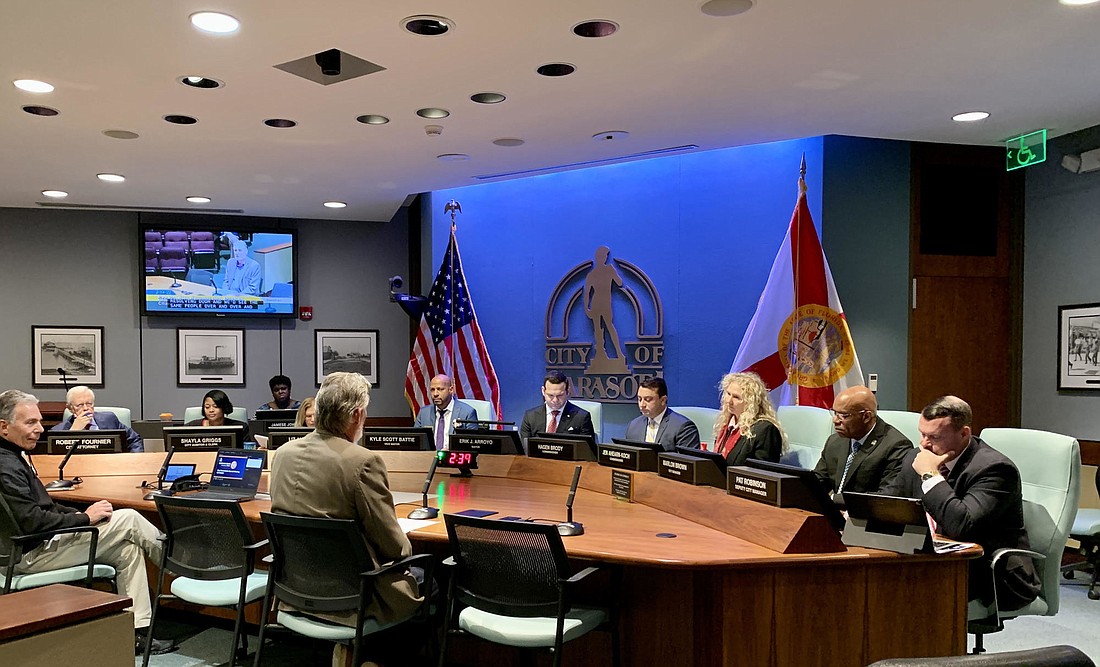- November 27, 2024
-
-
Loading

Loading

City commissioners on Monday stuck with a list of projects in step with recommendations from a citizen advisory board on penny-surtax spending but not before rejecting the suggestion of a shorter list and bigger-ticket price points.
In a special meeting at City Hall, commissioners voted 4-1 to largely accept the Surtax IV Ad Hoc Committee’s list of 23 projects on which to spend an estimated $191 million between 2025 and 2039.
Eliminating a proposal to spend $900,000 to build public bathrooms in business and retail areas and adding back a proposal to spend a portion of the city’s penny-tax share on city-building renovations and upgrades, commissioners tasked city staff to rebalance the item-by-item dollar allocations before final approval.
Commissioners also approved adding some funding for the eventual replacement of the Van Wezel Performing Arts Hall, though that project has yet to come before the City Commission to consider.
Read more: Siesta Key residents check in with their own ideas
In rejecting a deeper rework of the committee’s deliberations, Commissioner Liz Alpert said that budgetary oversight is a commission function, but she praised the committee’s work in setting surtax-spending priorities.
"Could some things be reworked a little? Obviously, they could," she said. "We can have staff look at some ways because they’re the ones who understand what they need, what it’s going to cost. But if we want to sit and start doing that, then I think we should have a lot of special meetings because I don’t think it should be off the top of our head we’re going to go through this without any facts and any data and just say we’re now going to redo it."
Read more: Longboat Key finalizes its surtax list
After city staff’s work, a March 7 meeting is planned to vote on a final resolution containing the city’s project priorities to deliver to the County Commission. From there, if approved at the county level, a referendum on renewing the 1% additional sales tax in November.
The committee began its work in May 2021, conducting public workshops and soliciting ideas via email from residents and city staff. The winnowing process began with 54 ideas, which were either included in the committee’s list, discarded or combined with similar notions.
The committee then added estimated costs and worked with those to reduce the fully funded total of $450 million down to match with the $191 million estimate of the tax’s 15-year revenue.
"At the end of the day, we pretty much had a consensus among all of the committee members on how we allocated the money," said Carl Shoffstall, the chair of the advisory board.
City Manager Marlon Brown reminded commissioners that the $191 million figure used as a target is an estimate and that the budgeting of the revenue is an annual process.
“Things can go up, things can go down," he said. “We can add projects, we can remove projects."
Both Mayor Erik Arroyo and Commissioner Hagen Brody urged a different approach than merely adjusting the advisory committee’s work.
Brody suggested using $50 million to pay for projects within the city’s 10-year, $300 million water and sewer system improvement program, approved in 2019. As it stands, the city is two years into the project that calls for annual 3.5% increases in water and sewer rates between 2020 and 2030 to finance it. Brody said his suggestion was intended to cut into those rate increases.
Brody voted against those water and sewer rate increases in 2019, and current Commissioners Jen Ahearn-Koch and Liz Alpert voted for them.
On Monday, Ahearn-Koch and Alpert voted with Vice Mayor Kyle Battie in rejecting Brody's proposal.
"In my mind, my number is $50 million for water infrastructure … doesn’t have to be that," he said. "It could be more, it could be less. But what I’m looking for is a significant chunk of this infrastructure surtax money going to our water infrastructure improvements."
Brown told commissioners that the surtax dollars wouldn’t begin to flow to the city until 2025 and that the total would be spread across 15 years, watering down the effect on sewer rates.
“It’s not going to make an impact," Brown said, though federal infrastructure financing is likely in the pipeline earlier than 2025 and could be applied to the same end.
Arroyo said he preferred to “be bold” and recommended to allot:
"$70 million of that goes to workforce housing — that would make a dent in the lives of hundreds, if not thousands of people," he said.
Ahearn-Koch said such items as sidewalk repairs and street lighting, which are near the top of the advisory committee’s priorities, are things that benefit the entire city and help improve safety and quality of life.
"I don’t want to revisit what the committee did, what staff did," she said. "This is a long-term plan. We have to think long term with this. I don’t mind being bold, and I don’t mind doing things for our citizens, but sometimes what they really want are safe sidewalks and lighting so their children can get home from school safely."